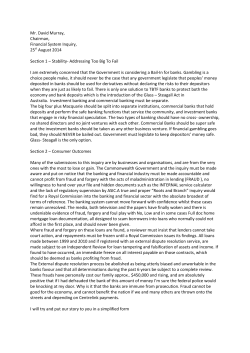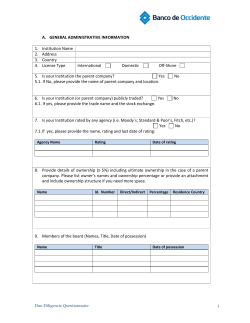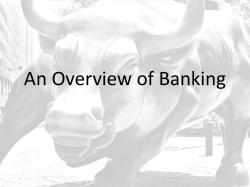
Role of Investment Banks
Role of Investment Banks • Investment banks help companies and governments and their agencies to raise money by issuing and selling securities in the primary market. They assist public and private corporations in raising funds in the capital markets (both equity and debt), • as well as in providing strategic advisory services for mergers, acquisitions and other types of financial transactions. • Investment banks also act as intermediaries in trading for clients. Investment banks differ from commercial banks, which take deposits and make commercial and retail loans. • In recent years, however, the lines between the two types of structures have blurred, especially as commercial banks have offered more investment banking services. • Investment banks may also differ from brokerages, which in general assist in the purchase and sale of stocks, bonds, and mutual funds. However some firms operate as both brokerages and investment banks; this includes some of the best known financial services firms in the world. • In the strictest definition, investment banking is the raising of funds, both in debt and equity, and the division handling this in an investment bank is often called the "Investment Banking Division" (IBD). • However, only a few small firms provide only this service. Almost all investment banks are heavily involved in providing additional financial services for clients, such as the trading of derivatives, fixed income, foreign exchange, commodity, and equity securities. • More commonly used today to characterize what was traditionally termed "investment banking" is "sell side." This is trading securities for cash or securities (i.e., facilitating transactions, marketmaking), or the promotion of securities (i.e. underwriting, research, etc.). • The "buy side" constitutes the pension funds, mutual funds, hedge funds, and the investing public who consume the products and services of the sell-side in order to maximize their return on investment. Many firms have both buy and sell side components. Organizational Structure of an Investment Bank Primary Function • The primary function of an investment bank is buying and selling products both on behalf of the bank's clients and also for the bank itself. Banks undertake risk through proprietary trading, done by a special set of traders who do not interface with clients and through Principal Risk, • Risk undertaken by a trader after he or she buys or sells a product to a client and does not hedge his or her total exposure. Banks seek to maximize profitability for a given amount of risk on their balance sheet. • An investment bank is split into the so-called Front Office, Middle Office and Back Office. Front Office • Investment Banking is the traditional aspect of investment banks which involves helping customers raise funds in the Capital Markets and advising on mergers and acquisitions. Investment bankers prepare idea pitches that they bring to meetings with their clients, • with the expectation that their effort will be rewarded with a mandate when the client is ready to undertake a transaction. • Once mandated, an investment bank is responsible for preparing all materials necessary for the transaction as well as the execution of the deal, which may involve subscribing investors to a security issuance, coordinating with bidders, or negotiating with a merger target. • Other terms for the Investment Banking Division include Mergers & Acquisitions (M&A) and Corporate Finance (often pronounced). Investment Management • The professional management of various securities (shares, bonds etc) and other assets (e.g. real estate), to meet specified investment goals for the benefit of the investors. Investors may be institutions (insurance companies, pension funds, corporations etc.) or • private investors (both directly via investment contracts and more commonly via collective investment schemes, mutual funds) . Sales and Trading Sales and Trading • is often the most profitable area of an investment bank. • responsible for the majority of revenue of most investment banks • In the process of market making, traders will buy and sell financial products with the goal of making an incremental amount of money on each trade. Sales is the term for the investment banks sales force, • whose primary job is to call on institutional and high-net-worth investors to suggest trading ideas (on caveat emptor basis) and take orders. Sales desks then communicate their clients' orders to the appropriate trading desks, who can price and execute trades, or structure new products that fit a specific need. Research Research • is the division which reviews companies and writes reports about their prospects, often with "buy" or "sell" ratings. While the research division generates no revenue, its resources are used to assist traders in trading, • the sales force in suggesting ideas to customers, and investment bankers by covering their clients. In recent years the relationship between investment banking and research has become highly regulated, reducing its importance to the investment bank. Structuring Structuring • has been a relatively recent division as derivatives have come into play, with highly technical and numerate employees working on creating complex structured products which typically offer much greater margins and returns than underlying cash securities. Middle Office • Risk Management involves analyzing the market and credit risk that traders are taking onto the balance sheet in conducting their daily trades, and setting limits on the amount of capital that they are able to trade in order to prevent 'bad' trades having a detrimental effect to a desk overall. • Another key Middle Office role is to ensure that the above mentioned economic risks are captured accurately (as per agreement of commercial terms with the counterparty) correctly (as per standardized booking models in the most appropriate systems) and on time (typically within 30 minutes of trade execution). • In recent years the risk of errors has become known as "operational risk" and the assurance Middle Offices provide now include measures to address this risk. When this assurance is not in place, market and credit risk analysis can be unreliable and open to deliberate manipulation. Back Office Back Office • Operations involves data-checking trades that have been conducted, ensuring that they are not erroneous, and transacting the required transfers. While it provides the greatest job security of the divisions within an investment bank, • it is a critical part of the bank that involves managing the financial information of the bank and ensures efficient capital markets through the financial reporting function. The staff in these areas are often highly qualified and need to understand in depth the deals and transactions that occur across all the divisions of the bank. Technology • Every major investment bank has considerable amounts of in-house software, created by the Technology team, who are also responsible for Computer and Telecommunicationsbased support. Technology has changed considerably in the last few years as more sales and trading desks are using electronic trading platforms. • These platforms can serve as autoexecuted hedging to complex model driven algorithms. Recent Evolution of the Business • Investment banking is one of the most global industries and is hence continuously challenged to respond to new developments and innovation in the global financial markets. Throughout the history of investment banking, • many have theorized that all investment banking products and services would be commoditized. • New products with higher margins are constantly invented and manufactured by bankers in hopes of winning over clients and developing trading knowhow in new markets. • However, since these can usually not be patented or copyrighted, they are very often copied quickly by competing banks, pushing down trading margins. • For example, trading bonds and equities for customers is not a commodity business, but structuring and trading derivatives is highly profitable. Each OTC contract has to be uniquely structured and could involve complex pay-off and risk profiles. • Listed option contracts are traded through major exchanges, such as the CBOE, and are almost as commoditized as general equity securities. Possible Conflicts of Interest • Potential conflicts of interest may arise between different parts of a bank, creating the potential for financial movements that could be market manipulation. Authorities that regulate investment banking require that banks impose a Chinese wall which • prohibits communication between investment banking on one side and research and equities on the other. • Many investment banks also own retail brokerages. Also during the 1990s, some retail brokerages sold consumers securities which did not meet their stated risk profile. • This behavior may have led to investment banking business or even sales of surplus shares during a public offering to keep public perception of the stock favorable. • Since investment banks engage heavily in trading for their own account, there is always the temptation or possibility that they might engage in some form of front running. National Role for Investment Banks • Investment banks are social institutions. They are custodians and trustees of the public’s money and promoting national interests— strengthening the sovereignty of our state technological up-gradation and reduction of asset distributional inequities—must be explicit objectives of their business strategy. • These objectives will not be unintentionally, automatically achieved by profit maximization. A strategy has to be crafted which deliberately synthesizes financial viability and profitability concerns with the concern for safeguarding national sovereignty and promoting national development. Recap Recap • Role of Investment Banks • Organizational Structure of an Investment Bank • Primary Function • Front Office • Investment Management • Sales and Trading • Research • • • • • • • Structuring Middle Office Back Office Technology Recent Evolution of the Business Possible Conflicts of Interest National Role for Investment Banks
© Copyright 2025










